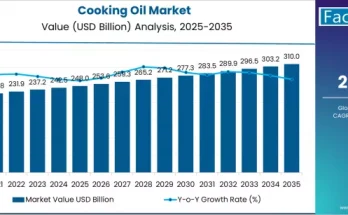The global aquaponics market is gaining rapid traction as sustainable agriculture and food security become global imperatives. According to a recent study by Fact.MR, the market is valued at USD 1.9 billion in 2025 and is projected to reach USD 4.6 billion by 2035, expanding at a CAGR of 9.2% over the forecast period. This growth represents a 142.1% absolute increase, driven by the integration of aquaculture and hydroponics to deliver resource-efficient, high-yield food systems.
Aquaponics—an eco-friendly cultivation approach combining fish farming and soilless plant growth—offers a closed-loop system that minimizes waste, conserves water, and supports year-round crop production. The technology is increasingly adopted across commercial farms, urban food projects, and research institutions as global demand for sustainable protein and plant sources rises.
Strategic Market Drivers
- Rising Focus on Sustainable Agriculture and Food Security
Aquaponics enables near-zero water wastage and nutrient recycling, addressing the growing scarcity of arable land and freshwater. Governments and private enterprises are investing heavily in aquaponic farms to strengthen local food systems, reduce import dependency, and promote sustainable urban agriculture. - Urban Farming and Controlled Environment Agriculture (CEA) Expansion
With rapid urbanization and population growth, cities are turning to vertical and indoor farming solutions. Aquaponics systems, which operate efficiently in limited spaces, are increasingly deployed in warehouses, rooftops, and modular setups—enabling local production of organic vegetables, herbs, and fish with minimal environmental impact. - Technological Advancements and Automation
The market is witnessing the integration of IoT sensors, AI-based monitoring systems, and automated nutrient control, enhancing productivity and scalability. Advanced systems ensure optimal water chemistry, pH balance, and temperature regulation, improving fish health and plant yield. - Growing Demand for Organic and Local Produce
Consumers’ preference for pesticide-free, locally sourced food is reshaping retail and foodservice supply chains. Aquaponics provides traceable, clean-label produce aligned with the growing organic and health-conscious consumer base.
Browse Full Report: https://www.factmr.com/report/1195/aquaponics-market
Regional Growth Highlights
North America: Innovation and Market Maturity
The U.S. and Canada are leading the adoption of aquaponics, driven by advanced CEA technologies and a strong push toward sustainable food systems. Numerous startups and research collaborations are scaling operations through commercial aquaponic farms and educational programs promoting circular food production.
Europe: Green Policy Support and High-Tech Farming
Europe’s aquaponics growth is propelled by stringent sustainability regulations and EU-funded projects promoting green agriculture. Countries such as the Netherlands, Germany, and the U.K. are pioneering urban aquaponic installations and research hubs integrating renewable energy with food production.
East Asia: Expanding Urban Food Infrastructure
East Asia—particularly China, Japan, and South Korea—is witnessing increasing investments in smart agriculture and urban farming. Aquaponics is gaining momentum due to its adaptability to densely populated regions and its role in advancing food resilience.
Emerging Markets: Africa, South Asia, and Latin America
Developing economies are adopting aquaponics to address food security challenges and mitigate climate impacts on agriculture. Government-backed initiatives and NGO-led programs are promoting small-scale aquaponic units for local communities and schools.
Market Segmentation Insights
By Component:
- Rearing Tanks
- Biofilter
- Hydroponic Subsystems
- Settling Basins
- Sumps and Pumps
By Application:
- Commercial Farming
- Home Production
- Research and Education
- Urban and Community Projects
By Fish Type:
- Tilapia
- Catfish
- Carp
- Trout
- Others
By Crop Type:
- Leafy Greens (Lettuce, Kale, Spinach)
- Herbs (Basil, Mint)
- Fruits and Vegetables (Tomatoes, Peppers, Strawberries)
Challenges and Market Considerations
- High Initial Investment: Advanced aquaponic systems require significant setup costs, particularly for automation and controlled environments.
- Technical Expertise Gap: Managing nutrient balance and water quality demands skilled operators and regular system monitoring.
- Regulatory and Certification Complexities: Lack of standardized frameworks for aquaponic produce certification affects market penetration.
- Energy Dependence: Continuous energy requirements for pumps, lighting, and temperature control pose challenges in regions with unstable power supply.
Competitive Landscape
The global aquaponics market is characterized by a blend of established agricultural technology companies and innovative startups developing modular, scalable, and energy-efficient systems. Strategic partnerships, R&D collaborations, and product diversification are key strategies shaping competition.
Key Players in the Aquaponics Market:
- Nelson & Pade
- Pentair
- Aquaponic Source
- ECF Farmsystems
- Urban Farms AG
- MyAquaponics
- AquaSprouts
- Aponic
- GreenLife Aquaponics
- Superior Fresh
Recent Developments
- March 2023 – Nelson & Pade launched an enhanced commercial aquaponics system with improved water circulation efficiency and integrated AI-based nutrient monitoring.
- January 2023 – Urban Farms AG expanded its vertical aquaponics facilities across major European cities, promoting urban self-sufficiency and education initiatives.
- October 2022 – Pentair introduced energy-efficient pumps and filtration units designed specifically for aquaponic farming applications.
Future Outlook: Toward Circular and Smart Food Systems
Over the next decade, the aquaponics market is poised for strong and sustained growth as climate resilience and food sovereignty become global priorities. Integration with renewable energy, AI-driven farm management, and community-scale projects will redefine the agricultural landscape.
Companies that prioritize sustainability, automation, and regional collaboration will lead the next phase of market evolution—delivering efficient, resource-smart solutions for a healthier planet and a sustainable food future.



